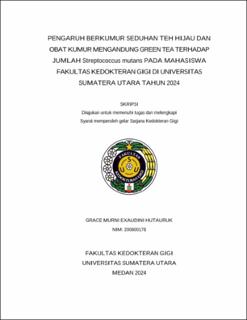| dc.contributor.advisor | Mtd, Siska Ella Natassa | |
| dc.contributor.author | Hutauruk, Grace Murni Exaudini | |
| dc.date.accessioned | 2024-09-11T03:23:58Z | |
| dc.date.available | 2024-09-11T03:23:58Z | |
| dc.date.issued | 2024 | |
| dc.identifier.uri | https://repositori.usu.ac.id/handle/123456789/97099 | |
| dc.description.abstract | Green tea (Camellia sinensis L.) is an herbal plant that has antibacterial
abilities with active ingredients such as polyphenols and catechins, which are
ingredients for making mouthwash in preventing the growth of bacteria that cause
caries. This study aims to determine the effect of gargling green tea brew with
mouthwash containing green tea on the number of Streptococcus mutans in students of
the Faculty of Dentistry, University of North Sumatra aged 19-23 years. This type of
research is a quasi-experimental with a pre and post test control group design.
Conducted on 22 respondents who met the inclusion and exclusion criteria and then
divided into two groups, each consisting of 11 subjects gargling green tea brew and
green tea mouthwash. Each group was instructed to gargle for 30 seconds. Saliva
collection was performed using the spitting method. Saliva samples were taken to the
laboratory for bacterial counts using the TPC (Total Plate Count) method. S. mutans
examination was grown in MSB (Mitis Salivarius Bacitracin) media stored in an
incubator at 37oC. The research data were tested for normality and homogeneity first.
The results showed that the average number of S. mutans decreased before gargling
and after gargling in the green tea steeping group and mouthwash containing green tea,
respectively 1653.36 ± 484.592 CFU/ml to 784.55 ± 206.763 CFU/ml and 1601 ±
462.297 CFU/ml to 1092.36 ± 319.740 CFU/ml. Data analysis using the Wilcoxon test
showed a significant decrease in the number of bacteria before and after gargling green
tea brew (p=0.003), with a paired T test showing a significant decrease in the number
of bacteria before and after gargling mouthwash containing green tea (p=0.001). The results of the unpaired T test showed that there was a significant difference in the mean difference in the number of bacteria between the green tea brew group and the green tea mouthwash (p<0.05). It can be concluded that green tea is more effective in reducing the number of bacteria than mouthwash containing green tea. So green tea can be used as a substitute for chemical mouthwash on the market because it has various advantages such as, easy to obtain, affordable prices, and does not contain chemicals that can cause side effects. | en_US |
| dc.language.iso | id | en_US |
| dc.publisher | Universitas Sumatera Utara | en_US |
| dc.subject | Green Tea | en_US |
| dc.subject | Mouthwash | en_US |
| dc.subject | Streptococcus Mutans | en_US |
| dc.subject | Antibacterial | en_US |
| dc.subject | SDGs | en_US |
| dc.title | Pengaruh Berkumur Seduhan Teh Hijau dan Obat Kumur Mengandung Green Tea terhadap Jumlah Streptococcus Mutans pada Mahasiswa Fakultas Kedokteran Gigi di Universitas Sumatera Utara Tahun 2024 | en_US |
| dc.title.alternative | The Effect of Gargling Green Tea and Mouthwash Containing Green Tea on The Number of Streptococcus mutans in Students of The Faculty of Dentistry at The University of North Sumatra in 2024 | en_US |
| dc.type | Thesis | en_US |
| dc.identifier.nim | NIM200600178 | |
| dc.identifier.nidn | NIDN0029118701 | |
| dc.identifier.kodeprodi | KODEPRODI12201#Pendidikan Dokter Gigi | |
| dc.description.pages | 95 Pages | en_US |
| dc.description.type | Skripsi Sarjana | en_US |


